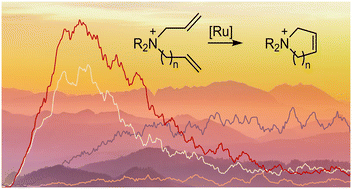Competitive isomerization and catalyst decomposition during ring-closing metathesis†
Abstract
Ring-closing metathesis (RCM) is an elegant means of forming cyclic structural elements in both simple and complex molecules. Mechanistically, the reaction cycle is well understood, though subtle details concerning the fate of the catalyst and the appearance of yield-reducing by-products remain to be fully deciphered. We applied real-time analysis using electrospray ionization mass spectrometry (ESI-MS) to probe the RCM reaction, including studying the dynamics of all charged species in the reaction mixture and investigating the nature of the by-products formed. The catalyst of choice was Grubbs' second-generation catalyst. The principal findings included the fact that for some substrates, significant by-products appeared that differed in mass from the starting material and product by increments of CH2; that isomerization reactions were responsible for these by-products; and that the catalyst decomposes to form charged products including [ClPCy3]+, [HPCy3]+, and the imidazolinium salt of the N-heterocyclic carbene (NHC) ligand. In cases where RCM is slow, isomerization reactions play a disproportionate part in effecting yield of the desired product.



 Please wait while we load your content...
Please wait while we load your content...